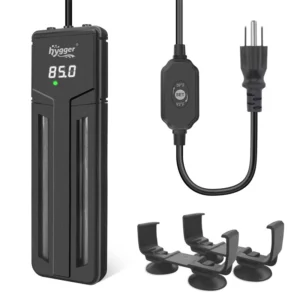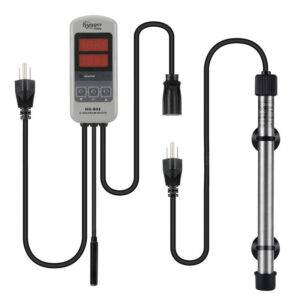Keeping fish is not easy for a good fish novice, one must create a tank before the purchase of fish to adapt to the fish’s survival environment. The aquarium heater plays a very important role in the fish tank. If you want to improve the quality of your fish’s lives, you should know more details about the aquarium heater. Today we discuss the topic: what size heater for a 20-gallon aquarium?
Content Table
Is It Necessary to Have a Heater in a Fish Tank?
Choosing a heat source for your fish tank is an important decision. The heat will increase the water temperature in your tank, which may cause your fish to die. It is also necessary to choose the correct temperature for your aquarium, and it is essential to use a heater that keeps your aquarium at a constant temperature. The temperature in your fish tank should not vary when the temperature of your room is at its lowest.
Some tropical fish like the water temperature to be around 74 degrees Fahrenheit. The best temperature is about 73.4 to 82.4 degrees Fahrenheit. Using a water heater will help you maintain the right water temperature for your tropical fish. A consistent water temperature will prevent your fish from freezing, which can lead to serious health problems. If the water is too cold, your fish will freeze and die.
A heater is essential for keeping your fish comfortable, and a good one will make your fish feel at home. If your tank is large, a heater should be placed near the water flow. If you have a small fish tank, two smaller ones can be placed in parallel to prevent winter disasters. There are two types of aquarium heaters: the first type is an in-pump heater that sits on top of the gravel.
Another type of aquarium heater is external. An external heater sits outside the tank and is more powerful than the internal one. But these are more expensive and require more maintenance.
Test Room Temperature Before Choosing an Aquarium Heater
When choosing a heater, you must first decide on what kind of fish tank you have. Tropical fish, for instance, require warm water and can survive in temperatures as low as 50 degrees Fahrenheit. Because they don’t produce body heat, they rely on the temperature of the water in their aquarium to keep them comfortable. Therefore, choosing the correct size heater for the tank is essential.
The size of your fish tank will determine the type of heater you need. A 60-gallon fish tank requires a 180-watt heater, a 300-watt aquarium heater, and a 480-watt heater for colder climates. To determine the right size heater, look for features such as an easy-to-use temperature control knob, an on/off light indicator, suction cups, and a mounting bracket. Make sure you select one that is made of impact-resistant glass and sealed with a waterproof seal.
The heater you choose should be sized for your aquarium’s size. The temperature difference between your tank and room temperature will determine the appropriate size heater. A 30-watt heater is required if the room temperature is five degrees cooler than your tank’s. For a 50-watt heater, a 10-degree difference is necessary. When the room temperature is 15 degrees lower than the tank’s temperature, an 80-watt unit is required.
If your room is ten degrees cooler than the temperature of the tank, you should choose a 200-watt heater. To make the tank temperature more than 15 degrees cooler, you should purchase a 320-watt heater.
How Many Watts Should Your Aquarium Heater Be
The size of the aquarium is one of the most important factors in selecting a fish tank heater. The more water the heater will heat, the higher the wattage required. Keep in mind that the larger the aquarium, the higher the wattage required. The following table shows the recommended wattage for an aquarium heater. Generally, it is recommended that you buy a heater with a rating of between 50 and 100 w.
The best way to determine the wattage needed for an aquarium heater is to use the average room temperature. If you’re trying to maintain a 65-degree temperature in your home, a 100-watt aquarium heater is the right choice. However, if you’re trying to keep the temperature of your fish tank at 80 degrees, then a 200-watt heater may be more suitable. You can also consider the type of heater you intend to buy.
Depending on the size of your aquarium, you can select an aquarium heater that meets your needs.

What Size Heater for a 20 Gallons Aquarium
A 20 gallon aquarium heater ensures the water temperature is constant. Fish do not like large temperature changes. In colder climates, this is a necessity. A good aquarium heater must provide five watts per gallon of water. Additionally, it must be fitted with a hood, which keeps the heat inside and helps reduce evaporation. A good range for your heater is 74 to 85 degrees, which is the temperature of freshwater fish.
The basic rule of thumb is that a tank needs at least five watts of heating power or five watts per gallon. This is only effective if you keep your tank at a typical room temperature. A 100-watt heater will be enough to maintain a 78-degree tank, but if you live in a colder climate, you may need a larger heater.
That said, a 50-watt heater is adequate for a fish tank of 20 gallons in a warm room (78 °F), but the efficiency goes down in colder fish tanks to only being usable in a 15-gallon fish tank. Here is a concise breakdown of aquarium heater wattage depending on the fish tank you have. For 20 gal tank or 30-gallon aquarium, use a 50 to 100-watt heater.
Purchasing an aquarium heater is an important decision for your aquarium. When choosing a heater, it is important to know the type of aquarium you have. Some heaters are better suited for large tanks, while others are more suited to smaller bodies. Keeping an eye on the temperature of your tank can help you determine which type of heater is right. If you are unsure of the size of your aquarium, you can always consult a tank-size table to determine the exact amount of wattage you need.
The cost of an aquarium heater is an important factor when choosing one. You need to consider the lifespan of the heater. If you buy a submersible heater, you should make sure that it will be able to withstand the varying temperatures of your aquarium. When you are concerned about its aesthetics, consider buying a tank with an integrated or external controller. Either way, you can choose the best heater for your needs.
If you’re unsure of the size of your tank, you can use the heater’s size chart. This will allow you to see which size you need. Look for a heater with a capacity chart so you can see how much temperature your tank requires. If it’s in between levels, you should purchase the next larger size. Otherwise, it would help if you considered purchasing a smaller heater first. This way, you’ll know exactly what size you need.
Conclusion
Regarding the best aquarium heater, as I mentioned in my other article: the best choice may not be what you are thinking about. You need to choose the finest aquarium heater rather than the best one. Go to this article for more details about how to choose the best aquarium heater. Let’s get together and choose the best suitable for your beloved fish.
A heater is also essential as auxiliary equipment for a fish tank 20-gallon aquascape. Breeders just need to install a heater to regulate the water temperature environment at any time in the winter, so that the fish can live normally and healthily all the time.


I have a 125 litre aquarium. I have a 150 watt heater in at the moment. At night the room temperature can drop to 14c. In the day time it’s kept at 18c. My tank temperature is kept at 26c. This room temperature is during the winter months. In summer the room temperature goes above 18c. Would I be better using a 200 watt heater in my tank, or two 100watt heaters.
Hi Karen, thanks for your comment.
According to your need, it is recommended to use a 200-watt heater like the hygger 003 heater which can accurately guarantee the temperature requirements for your tank.